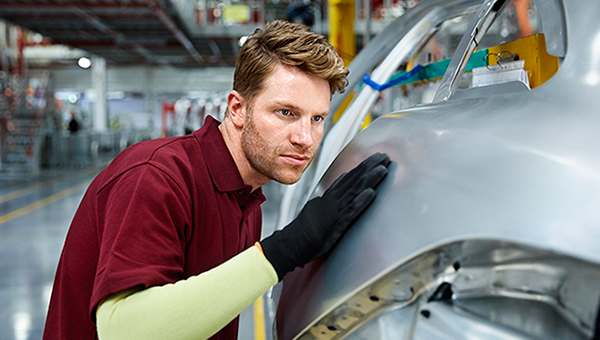An official website of the United States government
 United States Department of Labor
United States Department of Labor
| November 2018
Consider the work that goes into making the products you see every day. What is the process for developing and manufacturing them? Which occupations are involved? What are their wages and outlook?
For nearly all manufactured goods, workers in different occupations collaborate to develop an idea into a product. Take automobiles, for example: The combined efforts of workers such as designers, engineers, and assemblers result in the production of new and different cars each year.

According to the U.S. Bureau of Labor Statistics (BLS), the 2017 median annual wages for the occupations mentioned in this article were higher than $37,690, the median wage for all occupations. In addition, BLS projects thousands of openings annually from 2016 to 2026 in these occupations, primarily because of the need to replace existing workers who retire or leave the occupations permanently for other reasons.
Keep reading to learn more about some of the occupations involved in the manufacturing process, from creating a prototype (a kind of preliminary model) to making a product. We’ll highlight these occupations using automobiles as an example, although the data shown are for workers in all industries.
Every manufactured product begins as an idea. Industrial designers develop ideas into designs by creating digital images. Mechanical engineers and electrical engineers analyze these designs to determine how to build them into prototypes.
In our automobile manufacturing example, graphic designers create the look of a car’s interactive menus and improve their usability, such as determining what is on the main and subsequent screens. Systems software developers program how data from sensors, such as those that measure fuel temperature and engine speed, are used by the engine computer to make a car more fuel efficient. The product development team repeats the process of creating and reviewing prototypes until it arrives at a final design.
The occupations shown in table 1 accounted for 1.2 million jobs in 2016. More than a quarter of these jobs were in the manufacturing industry.
Combined, the occupations in table 1 are projected to have nearly 98,000 openings each year, on average, from 2016 to 2026. These projected openings are for occupations in all industries.
You typically need a bachelor’s degree to enter these occupations. In addition, you may need specific skills that vary by occupation. For example, industrial and graphic designers should be able to express design ideas visually.
Although products may be manufactured in small quantities, large-scale production is often more cost efficient. Cars, for example, are produced in large quantities and are standardized on an assembly line. Industrial engineers make decisions about the production process, such as the method or sequence of assembly, which is largely mechanized. Metal and plastic machine workers operate computer-controlled equipment or robots to perform tasks on the materials used in assembly.
The different parts and components are then put together by assemblers in sequence on the assembly line. Electricians and industrial machinery mechanics maintain and repair the conveyors, robots, and other equipment essential to production.
The occupations shown in table 2 accounted for about 2.5 million jobs in 2016. More than half of these jobs were in manufacturing.
From 2016 to 2026, these occupations as a whole are projected to have about 256,600 openings annually, on average. As mentioned previously, projected openings are calculated for occupations in all industries.
Of the occupations in table 2, assemblers is the one projected to have the most openings from 2016 to 2026. Even though employment in the occupation is projected to decline, there will be a need to replace workers who are leaving the occupation.
Industrial engineers is the only occupation in table 2 that typically requires workers to have a bachelor’s degree at the entry level. The other occupations usually require that workers have a high school diploma and on-the-job training, which may include an apprenticeship. And most states require that electricians be licensed.
BLS collects employment and wage data and provides employment projections for more than 800 occupations in over 300 industries. Learn more about the occupations in this article—and hundreds of others—in the Occupational Outlook Handbook (OOH). The OOH describes what workers do, what their job outlook is, what their typical entry-level education and training requirements are, and more.
Industries at a Glance snapshots provide more than 100 industry pages of data and information gathered from BLS programs and surveys. The manufacturing sector page includes an overview with links to data for 21 subsectors. The automotive industry page has data associated with several aspects of motor vehicles, including production.
Domingo Angeles, "From prototype to production: Careers that bring ideas into being," Career Outlook, U.S. Bureau of Labor Statistics, November 2018.